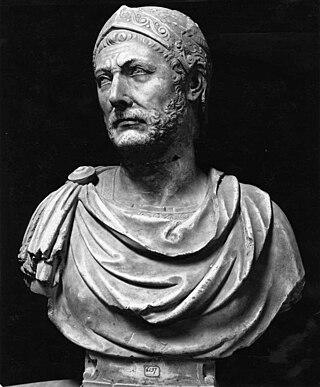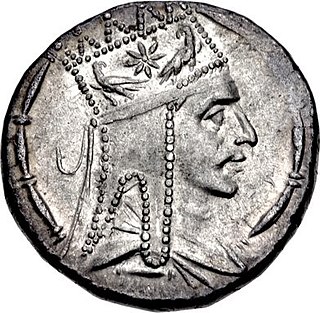Related Research Articles

Hannibal was a Carthaginian general and statesman who commanded the forces of Carthage in their battle against the Roman Republic during the Second Punic War.

Aurelian was a Roman emperor who reigned from 270 to 275 during the Crisis of the Third Century. As emperor, he won an unprecedented series of military victories which reunited the Roman Empire after it had nearly disintegrated under the pressure of barbarian invasions and internal revolts. Born in modest circumstances, most likely in Moesia Superior, he entered the Roman army in 235 and climbed up the ranks. He went on to lead the cavalry of the emperor Gallienus, until Gallienus' assassination in 268. Following that, Claudius Gothicus became emperor until his own death in 270. Claudius' brother Quintillus then ruled for three months, before Aurelian took the empire for himself.

The Crisis of the Third Century, also known as the Military Anarchy or the Imperial Crisis (235–284), was a period in Roman history during which the Roman Empire nearly collapsed under the combined pressure of repeated foreign invasions, civil wars and economic disintegration. At the height of the crisis, the Roman state split into three distinct and competing polities.

The Battle of Cannae was a key engagement of the Second Punic War between the Roman Republic and Carthage, fought on 2 August 216 BC near the ancient village of Cannae in Apulia, southeast Italy. The Carthaginians and their allies, led by Hannibal, surrounded and practically annihilated a larger Roman and Italian army under the consuls Lucius Aemilius Paullus and Gaius Terentius Varro. It is regarded as one of the greatest tactical feats in military history and one of the worst defeats in Roman history, and it cemented Hannibal's reputation as one of antiquity's greatest tacticians.
From its origin as a city-state on the peninsula of Italy in the 8th century BC, to its rise as an empire covering much of Southern Europe, Western Europe, Near East and North Africa to its fall in the 5th century AD, the political history of Ancient Rome was closely entwined with its military history. The core of the campaign history of the Roman military is an aggregate of different accounts of the Roman military's land battles, from its initial defense against and subsequent conquest of the city's hilltop neighbors on the Italian peninsula, to the ultimate struggle of the Western Roman Empire for its existence against invading Huns, Vandals and Germanic tribes. These accounts were written by various authors throughout and after the history of the Empire. Following the First Punic War, naval battles were less significant than land battles to the military history of Rome due to its encompassment of lands of the periphery and its unchallenged dominance of the Mediterranean Sea.

The Macedonian Wars were a series of conflicts fought by the Roman Republic and its Greek allies in the eastern Mediterranean against several different major Greek kingdoms. They resulted in Roman control or influence over Greece and the rest of the eastern Mediterranean basin, in addition to their hegemony in the western Mediterranean after the Punic Wars. Traditionally, the "Macedonian Wars" include the four wars with Macedonia, in addition to one war with the Seleucid Empire, and a final minor war with the Achaean League. The most significant war was fought with the Seleucid Empire, while the war with Macedonia was the second, and both of these wars effectively marked the end of these empires as major world powers, even though neither of them led immediately to overt Roman domination. Four separate wars were fought against the weaker power, Macedonia, due to its geographic proximity to Rome, though the last two of these wars were against haphazard insurrections rather than powerful armies. Roman influence gradually dissolved Macedonian independence and digested it into what was becoming a leading empire. The outcome of the war with the now-deteriorating Seleucid Empire was ultimately fatal to it as well, though the growing influence of Parthia and Pontus prevented any additional conflicts between it and Rome.

Armenia, also the Kingdom of Greater Armenia or simply Greater Armenia or Armenia Major, sometimes referred to as the Armenian Empire under Tigranes II, was a kingdom in the Ancient Near East which existed from 331 BC to 428 AD. Its history is divided into the successive reigns of three royal dynasties: Orontid, Artaxiad, and Arsacid (52–428).
Avalanche Press is an American company that publishes board wargames and has published some role-playing game supplements. The company was founded in 1993 and is headquartered in Irondale, Alabama.
This page lists board and card games, wargames, miniatures games, and tabletop role-playing games published in 2002. For video games, see 2002 in video gaming.

Relations between the Roman and Iranian states were established c. 92 BC. It was in 69 BC that the two states clashed for the first time; the political rivalry between the two empires would dominate much of Western Asia and Europe until 628. Initially commencing as a rivalry between the Parthians and Rome, from the 3rd to mid-7th centuries the Roman Empire and its rival Sassanid Persia were recognized as two of the leading powers in the world.

Tactical wargames are a type of wargame that models military conflict at a tactical level, i.e. units range from individual vehicles and squads to platoons or companies. These units are rated based on types and ranges of individual weaponry. The first tactical wargames were played as miniatures, extended to board games, and they are now also enjoyed as video games.

Rome: Total War: Barbarian Invasion is the first expansion pack for the strategy video game Rome: Total War. The expansion was released in 2005 in North America and Europe and in 2006 in Japan for Windows. Feral Interactive released the iPad version on 28 March 2017, the iPhone version on 9 May 2019, and an Android version of the game on 18 June 2019. A remastered version of the game was released as part of Total War: Rome Remastered on 29 April 2021. While the main game deals with the rise of the Roman Empire, Barbarian Invasion covers the decline and fall of the Western Roman Empire during the Migration Period.
This page lists board and card games, wargames, miniatures games, and tabletop role-playing games published in 2007. For video games, see 2007 in video gaming.
The Panzer Grenadier series of board wargames is Avalanche Press's series of World War II and The Korean War tactical land combat. The first game in the series was released in 2000.
Roman infantry tactics are the theoretical and historical deployment, formation, and manoeuvres of the Roman infantry from the start of the Roman Republic to the fall of the Western Roman Empire. The original Roman army was made up of hoplites, whose main strategy was forming into a phalanx. By the early third century BCE, the Roman army would switch to the maniple system, which would divide the Roman army into three units, hastati, principes, and triarii. Later, in 107 BCE, Marius would institute the so-called Marian reforms, creating the Roman legions. This system would evolve into the Late Roman Army, which utilized the comitatenses and limitanei units to defend the Empire.

Total War: Rome II is a strategy video game developed by Creative Assembly and published by Sega. It was released on 3 September 2013, for Microsoft Windows as the eighth standalone game in the Total War series of video games and the successor to the 2004 game Rome: Total War.
References
- ↑ "Rome at War: Hannibal at Bay". Avalanche Press. Retrieved 2008-05-14.
- ↑ Rome at War series - Queen of the Celts